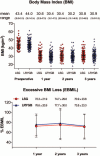Laparoscopic Sleeve Gastrectomy Versus Roux-Y-Gastric Bypass for Morbid Obesity-3-Year Outcomes of the Prospective Randomized Swiss Multicenter Bypass Or Sleeve Study (SM-BOSS)
- PMID: 28170356
- PMCID: PMC5300030
- DOI: 10.1097/SLA.0000000000001929
Laparoscopic Sleeve Gastrectomy Versus Roux-Y-Gastric Bypass for Morbid Obesity-3-Year Outcomes of the Prospective Randomized Swiss Multicenter Bypass Or Sleeve Study (SM-BOSS)
Abstract
Objective: Laparoscopic sleeve gastrectomy (LSG) is performed almost as often in Europe as laparoscopic Roux-Y-Gastric Bypass (LRYGB). We present the 3-year interim results of the 5-year prospective, randomized trial comparing the 2 procedures (Swiss Multicentre Bypass Or Sleeve Study; SM-BOSS).
Methods: Initially, 217 patients (LSG, n = 107; LRYGB, n = 110) were randomized to receive either LSG or LRYGB at 4 bariatric centers in Switzerland. Mean body mass index of all patients was 44 ± 11 kg/m, mean age was 43 ± 5.3 years, and 72% of patients were female. Minimal follow-up was 3 years with a rate of 97%. Both groups were compared for weight loss, comorbidities, quality of life, and complications.
Results: Excessive body mass index loss was similar between LSG and LRYGB at each time point (1 year: 72.3 ± 21.9% vs. 76.6 ± 20.9%, P = 0.139; 2 years: 74.7 ± 29.8% vs. 77.7 ± 30%, P = 0.513; 3 years: 70.9 ± 23.8% vs. 73.8 ± 23.3%, P = 0.316). At this interim 3-year time point, comorbidities were significantly reduced and comparable after both procedures except for gastro-esophageal reflux disease and dyslipidemia, which were more successfully treated by LRYGB. Quality of life increased significantly in both groups after 1, 2, and 3 years postsurgery. There was no statistically significant difference in number of complications treated by reoperation (LSG, n = 9; LRYGB, n = 16, P = 0.15) or number of complications treated conservatively.
Conclusions: In this trial, LSG and LRYGB are equally efficient regarding weight loss, quality of life, and complications up to 3 years postsurgery. Improvement of comorbidities is similar except for gastro-esophageal reflux disease and dyslipidemia that appear to be more successfully treated by LRYGB.
Conflict of interest statement
The authors report no conflicts of interest.
Figures


Comment in
-
Are Guidelines for Standardized Outcome Reporting in Bariatric Surgery Responsible for Missing the Big Picture in Bariatric Surgery Related Major Complications?Ann Surg. 2018 Jul;268(1):e12-e13. doi: 10.1097/SLA.0000000000002314. Ann Surg. 2018. PMID: 28549008 No abstract available.
-
Response to: "Are Guidelines for Standardized Outcome Reporting in Bariatric Surgery Responsible for Missing the Big Picture in Bariatric Surgery Related Major Complications?".Ann Surg. 2018 Jul;268(1):e13-e14. doi: 10.1097/SLA.0000000000002317. Ann Surg. 2018. PMID: 29889680 No abstract available.
Similar articles
-
Early results of the Swiss Multicentre Bypass or Sleeve Study (SM-BOSS): a prospective randomized trial comparing laparoscopic sleeve gastrectomy and Roux-en-Y gastric bypass.Ann Surg. 2013 Nov;258(5):690-4; discussion 695. doi: 10.1097/SLA.0b013e3182a67426. Ann Surg. 2013. PMID: 23989054 Free PMC article. Clinical Trial.
-
Effect of Laparoscopic Sleeve Gastrectomy vs Laparoscopic Roux-en-Y Gastric Bypass on Weight Loss in Patients With Morbid Obesity: The SM-BOSS Randomized Clinical Trial.JAMA. 2018 Jan 16;319(3):255-265. doi: 10.1001/jama.2017.20897. JAMA. 2018. PMID: 29340679 Free PMC article. Clinical Trial.
-
Conversion of failed laparoscopic adjustable gastric banding: sleeve gastrectomy or Roux-en-Y gastric bypass?Surg Obes Relat Dis. 2013 Nov-Dec;9(6):901-7. doi: 10.1016/j.soard.2013.04.003. Epub 2013 Apr 17. Surg Obes Relat Dis. 2013. PMID: 23769112
-
A Comprehensive Comparison of LRYGB and LSG in Obese Patients Including the Effects on QoL, Comorbidities, Weight Loss, and Complications: a Systematic Review and Meta-Analysis.Obes Surg. 2020 Mar;30(3):819-827. doi: 10.1007/s11695-019-04306-4. Obes Surg. 2020. PMID: 31834563 Free PMC article.
-
Update on comparison of laparoscopic sleeve gastrectomy and laparoscopic Roux-en-Y gastric bypass: a systematic review and meta-analysis of weight loss, comorbidities, and quality of life at 5 years.BMC Surg. 2024 Jul 30;24(1):219. doi: 10.1186/s12893-024-02512-1. BMC Surg. 2024. PMID: 39080707 Free PMC article.
Cited by
-
Surgical Treatment of Obesity. Special Mention to Roux-en-Y Gastric Bypass and Vertical Gastrectomy.Front Endocrinol (Lausanne). 2022 Mar 31;13:867838. doi: 10.3389/fendo.2022.867838. eCollection 2022. Front Endocrinol (Lausanne). 2022. PMID: 35432187 Free PMC article. Review.
-
The Effect of Laparoscopic Sleeve Gastrectomy and Gastric Bypass Surgery on Non-Alcoholic Steatohepatitis in Iranian Patients with Obesity.Middle East J Dig Dis. 2021 Jul;13(3):200-207. doi: 10.34172/mejdd.2021.226. Epub 2021 May 11. Middle East J Dig Dis. 2021. PMID: 36606220 Free PMC article.
-
Targeting Islets: Metabolic Surgery Is More than a Bariatric Surgery.Obes Surg. 2019 Sep;29(9):3001-3009. doi: 10.1007/s11695-019-03979-1. Obes Surg. 2019. PMID: 31187459 Review.
-
Long-term (11 Years) Results of Laparoscopic Gastric Bypass: Changes in Weight, Blood Levels of Sugar and Lipids, and Late Adverse Effects : Laparoscopic Gastric Bypass Results.Obes Surg. 2024 Sep;34(9):3266-3274. doi: 10.1007/s11695-024-07249-7. Epub 2024 May 17. Obes Surg. 2024. PMID: 38760651
-
In Terms of Nutrition, the Most Suitable Method for Bariatric Surgery: Laparoscopic Sleeve Gastrectomy or Roux-en-Y Gastric Bypass? A Systematic Review and Meta-analysis.Obes Surg. 2020 May;30(5):2003-2014. doi: 10.1007/s11695-020-04488-2. Obes Surg. 2020. PMID: 32077060
References
-
- Sjostrom L. Review of the key results from the Swedish Obese Subjects (SOS) trial—a prospective controlled intervention study of bariatric surgery. J Intern Med 2013; 273:219–234. - PubMed
-
- Angrisani L, Santonicola A, Iovino P, et al. Bariatric surgery worldwide 2013. Obes Surg 2015; 25:1822–1832. - PubMed
-
- Wolnerhanssen BK, Peters T, Kern B, et al. Predictors of outcome in treatment of morbid obesity by laparoscopic adjustable gastric banding: results of a prospective study of 380 patients. Surg Obes Relat Dis 2008; 4:500–506. - PubMed
-
- Peterli R, Wolnerhanssen BK, Peters T, et al. Prospective study of a two-stage operative concept in the treatment of morbid obesity: primary lap-band followed if needed by sleeve gastrectomy with duodenal switch. Obes Surg 2007; 17:334–340. - PubMed
Publication types
MeSH terms
LinkOut - more resources
Full Text Sources
Other Literature Sources
Medical

